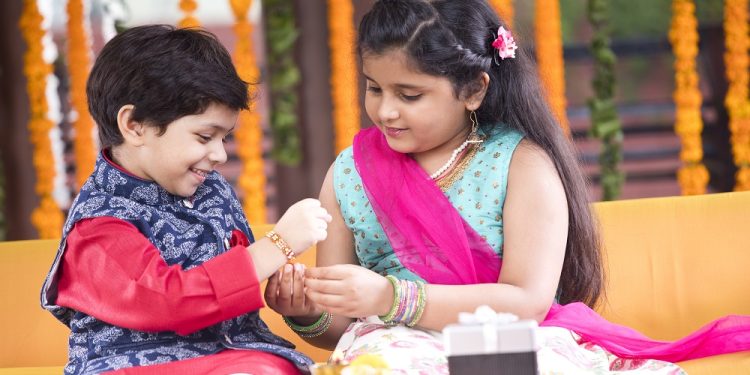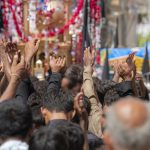
Raksha Bandhan
Raksha Bandhan is a Hindu ceremony and festival that’s observed in South Asia and is celebrated in parts of India, Pakistan, Nepal, and Mauritius. This Hindu festival celebrates the special bond that exists between brothers and sisters, and the love and honor that is shared between them.
On this day, also known as Rakshabandhan, sisters tie an amulet or talisman known as a rakhi around their brothers’ wrists. This provides their brothers with symbolic protection. In return, the brothers often give their sisters a gift of some type.
This gift can be a simple token of appreciation or it can be something a little more elaborate. The holiday is observed on the last day of Shraavana on the Hindu lunar calendar. This generally places it somewhere in August on the Gregorian calendar. The name of this holiday, Raksha Bandhan, means “the bond of protection or care” in Sanskrit.
The way this holiday is celebrated is a more modern take on the traditional Raksha Bandhan ritual. In ancient Hindu texts, a priest would tie talismans, amulets, or charms on their patrons’ wrists, or change their sacred threads. In exchange, the patron would give a gift of money to the priest or temple. In some parts of South Asia, this practice is still observed.
However, the modern incarnation of Raksha Bandhan is more closely tied to folk culture than religious tradition and is sometimes known by the name of the place where it’s observed. For example, there is a version of this holiday known as Saluno, and that festival includes sisters placing barley shoots behind their brothers’ ears.
The History Of Raksha Bandhan
Although the true origins of this festival and ritual can’t be accurately traced because they go back to antiquity, the first use in the English language dates back to the early 19th century. The Festival of the Bracelet, or Rakhi, can be found in “Annals and Antiquities of Rajasthan” by James Tod. It’s also referenced in several English-Hindu dictionaries of the time.
Almost 200-year-old reports of these festivals by scholars who have written about them have usually attributed the ritual as an observance in northern and central India, western India, Nepal, and Hindu communities in other countries such as Fiji. It’s often referred to by anthropologists as Sister’s Day, and some scholars have labeled it as a northern Indian festival.
This ritual can be found in Chapter 137 of the Uttara Parva of the Bhavishya Purana. In this chapter, Lord Krishna describes the ritual to Yudhishthira. In this text, it’s described as a ritual performed by the royal priest (or Purohit) on the full moon day (Purnima) in the month of Shravana on the Hindu lunar calendar.
To paraphrase that text: The priest should take a bath with pure water at the time of sunrise on Shravana month’s full moon day. He should then offer to the gods libations of water, as well as a libation to his paternal ancestors. In the afternoon, the priest then takes new silk or cotton cloth and adorns it with mustard seeds, barley or rice, and red ocher powder.
The priest should then bind the packet to the king’s wrist with the words “I am binding protection to you with the same words with which I bound the King of the Asuras, Mahabali.” Prayers are then offered to the Brahmins, Vaishyas, Kshatriyas, and Shudras. This then concludes the religious ceremony.
In the mid-1950s, alterations to this festival began to take place as noted by several prominent anthropologists. One change was that the charms went from being handmade to being made in factories.
The festival also changed from priests tying these charms to the wrists of their patrons, although it certainly still happens, to sisters tying them to their brothers’ wrists. Other changes to the festival have occurred throughout the years, including the expansion of the festival beyond its traditional borders.
Observances & Traditions Of Raksha Bandhan
Raksha Bandhan is often a festival that is connected to village or territorial exogamy. Exogamy is when a bride marries out of her town or village, and by custom, her parents do not visit her at her married home.
Rakhi was part of a festival in which married women can help preserve that connection between their married life and their natal village. In northern rural India, married Hindu women will travel back to their parents’ homes every year for the ceremony. Their brothers will typically travel to their married home and escort them back.
Some younger married women will travel back a couple of weeks before the ceremony to stay at their natal homes until the ceremony. As such, this ritual allows brothers to serve as intermediaries between their parental homes and their sisters’ married homes.
Preparation For The Ritual: Right before Raksha Bandhan, women will shop for the ceremonial thread that they are going to tie around their brothers’ wrists. This thread—also called a Rakhi—can be very simple or very ornate, depending on the woman’s choice. Also during this time, brothers will often search for gifts to give their sisters, which may also be something as simple as a token of affection or something much more elaborate.
The Ritual: On the day of the ritual, the siblings get together—along with members of their family—and it begins in front of a lit candle or lamp. It is there that they face each other and the sister ties the ceremonial thread to her brother’s wrist.
After The Ritual: Immediately following the tying of the thread, the sister often says a special prayer for her brother. Following the prayer, the sister then applies a tilak to her brother’s forehead, and he, in turn, promises to protect her. The sister then feeds her brother an assortment of different seasonal foods.
In some instances, there can be a tradition of voluntary kin relations. This is among men and women who aren’t blood relatives and can be achieved by the tying of Rakhi amulets. Some traditions also allow a matriarch to be included in the ceremony. This tradition allows men who are in a high caste to receive symbolic protection from women in a lower caste in a working relationship.
The lower caste women will offer the ritual thread and the high caste men will usually give them money or some other gift. In West Bengal, this festival is known as Jhulan Purnima. On this day, puja and prayers are offered to Lord Krishna, and sisters tie the Rakhi amulets to their brothers while they give them a blessing.
It’s also a day when friends, schools, and even offices hope for a good relationship with the people around them. In Jammu, in northern India, it’s common for people to fly kites on this day, just as they do on the day of Janmashtami. The sky is often filled with kites of all colors, shapes, and sizes.
In Nepal, the holiday is known as Janai Purnima, and it features a thread ceremony that’s observed not only by Hindus but also Buddhists. In some parts of Nepal, women tie rakhi on the wrists of their brothers and Hindu men change the sacred thread around their chests.








